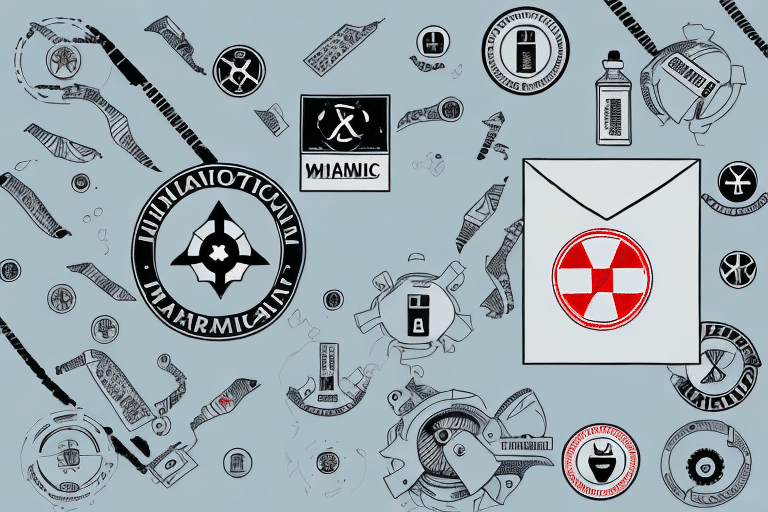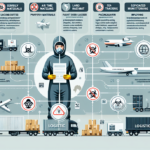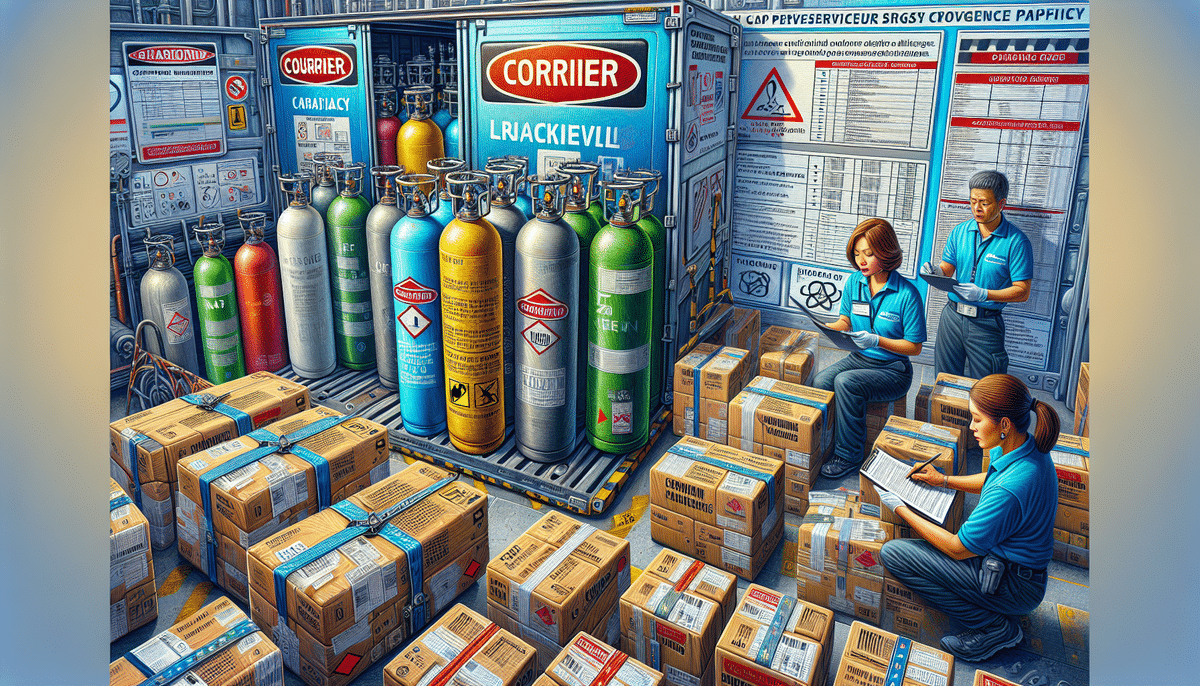Introduction to Safely Shipping Hazardous Materials
Shipping hazardous materials requires meticulous planning and adherence to safety protocols to prevent harm to individuals, property, and the environment. This comprehensive guide offers detailed insights into the best practices, regulatory requirements, and essential procedures for the safe transportation of hazardous materials.
Understanding the Risks of Shipping Hazardous Materials
Types of Hazardous Materials
Hazardous materials can be categorized as solids, liquids, or gases and are further classified based on their properties, such as flammability, reactivity, corrosiveness, or toxicity. Common examples include explosives, flammable liquids, toxic substances, and radioactive materials.
Potential Consequences of Mishandling
Mishandling hazardous materials can lead to severe consequences, including fires, explosions, environmental contamination, and health hazards. According to the Occupational Safety and Health Administration (OSHA), accidents involving hazardous materials account for a significant number of workplace injuries and fatalities each year.
Regulatory Requirements
Key Regulatory Bodies
Shipping hazardous materials is regulated by various governmental and international bodies to ensure safety and compliance. Key regulators include:
- United States Department of Transportation (DOT): Oversees the transportation of hazardous materials within the United States.
- International Air Transport Association (IATA): Regulates air transport of hazardous materials internationally.
- International Maritime Organization (IMO): Governs the shipping of hazardous materials by sea through the International Maritime Dangerous Goods (IMDG) Code.
Compliance with Regulations
Compliance with regulatory requirements is essential to avoid penalties and ensure safety. This includes proper classification, packaging, labeling, and documentation of hazardous materials. Non-compliance can result in hefty fines and increased liability in the event of an accident.
Classification of Hazardous Materials
Hazard Classes
There are nine hazard classes used to categorize hazardous materials based on their primary hazard:
- Explosives
- Gases
- Flammable Liquids
- Flammable Solids
- Oxidizers and Organic Peroxides
- Toxic Substances and Infectious Materials
- Radioactive Materials
- Corrosive Substances
- Miscellaneous Hazardous Materials
Each class has specific shipping restrictions and requirements that must be adhered to during transportation.
Shipping Restrictions per Class
Shipping restrictions vary by hazard class. For example, explosives require specialized packaging and labeling, while toxic substances must be clearly marked with hazard warnings. It's crucial to consult the appropriate regulations for each hazard class to ensure safe and compliant shipping.
Packaging, Labeling, and Marking
Choosing the Right Packaging
Proper packaging is vital to contain, cushion, and protect hazardous materials during transport. The packaging must be compatible with the material's chemical and physical properties. Common packaging types include drums, bottles, cans, and boxes, each designed for specific types of hazardous materials.
- Drums: Ideal for liquids and solids, providing durability and containment.
- Bottles and Cans: Suitable for smaller quantities and specific chemical properties.
- Boxes: Used for packaging multiple items or materials requiring additional protection.
Best Practices for Labeling
Labels must accurately reflect the hazardous materials' identity, hazard class, and proper shipping name. They should also display quantity, emergency contact information, and handling instructions. Adhering to standardized labeling practices ensures that all parties involved in the transport process can easily identify and manage the materials safely.
For more information on labeling requirements, refer to the Pipeline and Hazardous Materials Safety Administration (PHMSA).
Marking Requirements
Markings on packaging should include the UN number, which uniquely identifies the hazardous material, and other relevant symbols indicating the type of hazard. These markings are essential for emergency responders to quickly understand the nature of the material in case of an incident.
Transportation Modes and Carrier Selection
Air Transport
Shipping hazardous materials by air is subject to stringent regulations set by the International Air Transport Association (IATA). These regulations dictate specific packaging, labeling, and documentation requirements to ensure safety during flight.
Ground Transport
Ground transportation of hazardous materials is regulated by the DOT. This includes compliance with the Hazardous Materials Regulations (HMR), which cover aspects such as vehicle specifications, driver qualifications, and routing restrictions.
Sea Transport
Shipping hazardous materials by sea must adhere to the International Maritime Dangerous Goods (IMDG) Code. This code outlines the necessary packaging, labeling, and stowage procedures to prevent accidents and environmental contamination.
Selecting the Right Carrier
Choosing a freight company with experience in handling hazardous materials is crucial. Ensure that the carrier is compliant with all relevant regulations and has the necessary certifications. Additionally, consider the carrier's safety record, emergency response capabilities, and insurance coverage.
Handling, Storage, and HazMat Training
Proper Handling Procedures
Handling hazardous materials requires trained personnel who understand the risks and proper procedures. This includes using appropriate personal protective equipment (PPE), following established protocols, and maintaining a clean and organized work environment to prevent accidents.
Storage Requirements
Hazardous materials must be stored in designated areas that meet regulatory standards for ventilation, lighting, and fire protection. Proper storage practices include segregating incompatible materials, securing containers to prevent spills, and regularly inspecting storage facilities for compliance.
Training for Personnel
Comprehensive HazMat training is essential for all employees involved in the shipping process. Training should cover regulatory requirements, hazard identification, proper packaging and labeling, emergency response, and safe handling and storage practices. Regular training sessions ensure that personnel remain knowledgeable and compliant with current regulations.
For more details on training requirements, visit the OSHA Hazardous Materials Standards.
Emergency Response and Liability
Emergency Response Planning
Despite best efforts, accidents may still occur during the shipping of hazardous materials. An effective emergency response plan should include procedures for notification, evacuation, containment, and cleanup. All personnel should be familiar with the plan and their specific roles in the event of an emergency.
Developing an emergency response plan in accordance with the PHMSA Emergency Response Programs is essential for minimizing the impact of any incidents.
Liability and Insurance Considerations
Shipping hazardous materials increases liability and insurance risks. It is crucial to secure comprehensive liability insurance that covers regulatory compliance, carrier selection, emergency response, and spill cleanup. Regularly reviewing and updating insurance policies ensures adequate coverage for any changes in hazardous materials or transportation methods.
Environmental Impacts
Mishandling or improper disposal of hazardous materials can lead to significant environmental damage, including soil and water contamination. Adhering to proper handling, storage, and disposal procedures is essential to minimize environmental impact. Organizations should also implement measures to reduce the environmental footprint of their shipping operations.
For guidance on environmental protection, refer to the Environmental Protection Agency (EPA).
Conclusion
Safely shipping hazardous materials is a complex process that requires a thorough understanding of the associated risks, regulatory requirements, and best practices. By following the guidelines outlined in this guide, you can ensure the safe transportation of hazardous materials, protecting personnel, property, and the environment. Always stay informed about the latest regulations, invest in proper training, and choose reliable carriers to maintain the highest standards of safety and compliance.




















